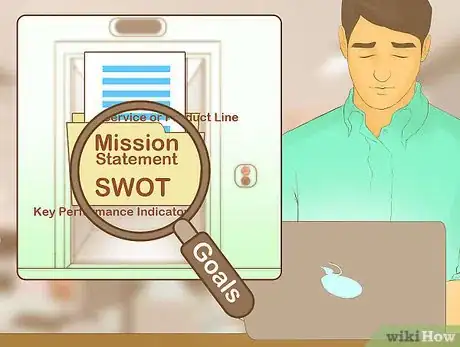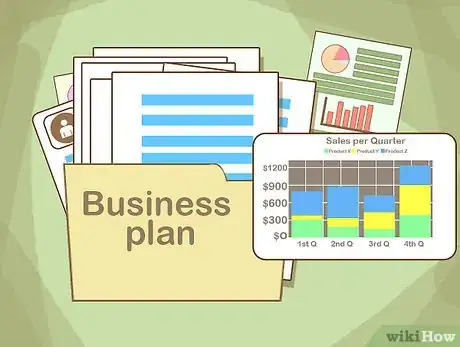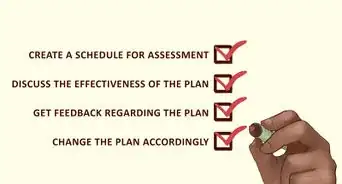This article was co-authored by Keila Hill-Trawick, CPA. Keila Hill-Trawick is a Certified Public Accountant (CPA) and owner at Little Fish Accounting, a CPA firm for small businesses in Washington, District of Columbia. With over 15 years of experience in accounting, Keila specializes in advising freelancers, solopreneurs, and small businesses in reaching their financial goals through tax preparation, financial accounting, bookkeeping, small business tax, financial advisory, and personal tax planning services. Keila spent over a decade in the government and private sector before founding Little Fish Accounting. She holds a BS in Accounting from Georgia State University - J. Mack Robinson College of Business and an MBA from Mercer University - Stetson School of Business and Economics.
There are 15 references cited in this article, which can be found at the bottom of the page.
wikiHow marks an article as reader-approved once it receives enough positive feedback. In this case, 100% of readers who voted found the article helpful, earning it our reader-approved status.
This article has been viewed 56,489 times.
A business plan is a document that provides an overview of your current business, outlines the results you want to achieve and details the steps you will take to achieve them. It can be used to attract potential investors, educate potential employees, or to help you run your business in a way that will achieve its goals. Follow these steps to write an effective business plan.
Steps
Choosing the Type of Plan
-
1Know why you are writing your business plan. Those reasons will inform the type of plan you write. Here are a few reasons:[1]
- You are testing out a business idea to see if it will work.
- You need financing or additional financing. Investors will want to see an updated plan.
- You are updating your plan periodically to serve as a guide for your business.
- There has been a significant change in the market.
- Your business has changed considerably, due to the introduction of new products, technology, services, or skills.
- You have had a change in management, and the new managers need clear information about the state of your business and how it will achieve its goals.
-
2Write a miniplan to introduce your company to prospective investors, lenders, or business partners, or to test a business concept.[2] A miniplan should be 1 to 10 pages and include the business concept, financing needs, marketing plan, and financial statements such as cash flow, income projections, and balance sheet.[3]Advertisement
-
3Write a working plan to help guide you in running your business. This is a living document that you will regularly update, particularly when your business or the market changes. It contains all the details of a standard business plan, but is not overly concerned with presentation.
-
4Write a presentation plan to show to bankers, investors, and others outside your company. While a working plan acts as a reminder to management of the company’s goals and plans, a presentation plan is an introduction. It will have a much greater emphasis on aesthetics than a working plan.[4]
-
5Create an electronic plan for presentations. It is useful to have a version of your presentation plan that can be shown via an overhead projector for presentations. Additionally, an electronic version of the plan might feature more in-depth figures and other information for interested investors.[5]
Preparing the Content
-
1Start with an executive summary. But write it last, because it summarizes the details of the rest of you plan.[6] This is a compelling overview of where your business is now, where it is going, and how it will get there. It allows employees, advisors, and investors to quickly understand your business.[7] Consider including the following:[8]
- A summary of your mission statement, explaining what your business is about.
- Company information, including when it was formed, the names of the founders, the number of employees, and location.
- Growth highlights.
- A brief description of your products and services.
- A brief summary of future plans.
-
2Lay out your business concept. In this section, you will discuss your business – the products you produce, your strengths and weaknesses, how you measure success, etc. It allows employees and investors to understand the current position and goals of your business.[9] Consider including:
- Elevator Pitch – A brief description of your business that will help you and your employees clearly and concisely articulate the nature of your business.[10]
- Mission Statement – A more complete statement of what your business is trying to achieve than that found in the Executive Summary.[11]
- Values and Guiding Principles – A statement of the core values that guide everyday practice in your company.[12]
- SWOT – An acronym for Strengths, Weaknesses, Opportunities, and Threats. These are crucial elements in understanding your company’s strategic position.[13] It helps you to identify which strengths you should target in the near future to take advantage of opportunities and deal with threats.[14]
- Service or Product Line – A description that emphasizes the customer needs you serve and the benefits you provide to consumers.[15]
- Goals – Setting goals is a key part of creating a successful business. Include 5 year or long-term goals, one-year goals, and shorter quarterly and monthly goals. This section will need to be updated regularly.[16]
- Key Performance Indicators (KPIs) – KPIs help to convert your goals into specific performance targets.[17]
“Underlying” KPIs are particularly important, as they help you to understand your business’s performance and adjust accordingly. For example, if sales are impacted by the number of visitors to your website and the number who complete a contact form, then these numbers should be tracked so that decreases can be addressed before they impact sales.[18]
Look for KPIs that:[19]
- Are non-financial, i.e. not expressed in dollar terms.
- Are taken daily or weekly.
- Are connected to clear corrective actions if the measure performs poorly.
- Have been tested so that they encourage appropriate action. Poor measures can encourage unintended negative behavior.
-
3Define the market for the product. Here you will describe the state of the market, analyze your customers (or potential customers), and discuss the competition. Understanding the market place allows you to make strategic decisions about how your product will fit into it.[20] Consider including:
- Industry Analysis – Make sure you narrow your target market to a manageable size. You will want to quantify your market (total sales, profits, etc.) and explain current market trends.[21] You will want to do an analysis to make sure the market is growing and to identify emerging opportunities.[22] If you are just starting your business, you will want to calculate the market share percentage and number of customers you expect to obtain in a defined geographic area.[23]
- Customer Analysis – Analyze the existing customer spread by type, values, and products/services, including major accounts.[24] Knowing the wants and needs of your customers will help you tailor your products and services to them, as well as helping you to focus your marketing efforts.[25]
- Competitor Analysis – The goal is not to list every detail about all competitors, but rather to identify your key competitors and their strengths and weaknesses. This will allow you to determine your current competitive advantage and ways to develop further advantages.[26]
- Routes to Market – Detail the other organizations or individuals that you will work with to develop your market, including what they gain by working with you.[27]
- Regulatory Restrictions – Include any customer or governmental regulatory requirements affecting your business, and how you’ll comply. Make sure to take into account the cost of compliance.[28]
-
4Make a plan to achieve your goals. This section will include all the steps you intend to take to market and sell your product and or service so as to reach your goals, as well as evidence that such steps have worked in the past. Consider including:
- Marketing Plan – Marketing is the process of creating new customers. Your overall marketing strategy should detail how you will penetrate the market, grow your business, locate channels of distribution, and communicate to your customers.[29]
- Sales Plan – This will include a sales force strategy, including whether you will have internal or independent representatives, how many, and how they will be recruited, trained, and compensated. It will also address your sales activities, such as making a list of contacts, prioritizing those with the highest potential, and identifying the number of sales calls you will need to make.[30]
- Team – This is where you make sure you have the necessary human resources to achieve your goals. Here you will list current team members, as well as the types of people you will need to hire to achieve your goals.[31]
- Operations Plan – In this section, you will identify the individual projects that contribute to your larger goals and indicate how these projects will be completed. Map out each of your initiatives in a Gantt chart so you will know when each project will start and end, and who will lead it.[32]
- Case Studies and Track Record – A discussion of your track record with the strategies you are employing or case studies of similar strategies will help convince potential investors that your plans will work.[33]
-
5Present your financial projections. Your projections will consist of historical data showing how your company has performed, as well as projections in line with the goals and strategy you have laid out in the business plan.[34] You can use these projections to help assess which opportunities you should pursue and to quantify the goals you wish to achieve, such as units sold or customers attracted. In addition, the financial projections will help potential investors decide if they want to invest.[35]
- Include prospective data for the next five years.
- For each year, include forecasted income statements, balance sheets, cash flow statements, and capital expenditure budgets.
- Supply monthly or quarterly projections for the first year.
-
6Include an appendix that contains supporting materials such as management resumes and additional figures supplementary to the financial projections.
Writing the Plan
-
1Consult examples of business plans. After examining one or two plans for businesses similar to yours, you will have a much better idea of how they are written.
-
2Keep your writing simple. Use short sentences, straightforward wording (i.e. “use” instead of “utilize”), and as little jargon as possible.[36]
-
3Use bullet points. They help to organize and clearly present your thoughts. But be sure to flesh out your points with brief explanations.[37]
-
4Keep your business plan short. For most plans, 20 to 30 pages of text plus 10 pages for monthly projections, management resumes, and other details will suffice. The longer your business plan, the less likely people will carefully read it all.[38]
-
5Use business charts to make your numbers easier to understand. So as not to overwhelm readers, use summary charts for the most important numbers, with the detailed figures in the appendix. Charts are helpful to show sales, gross margin, net profits, cash flow, and net worth by year, as well as market share and market segments.
- If sales are divided into segments, used stacked bars like these to show the total.
- Put sources in a summary table near the chart.
- Be certain all charts are referenced in the text of the plan.
References
- ↑ http://www.entrepreneur.com/article/38290
- ↑ https://www.allbusiness.com/use-a-mini-business-plan-to-arouse-interest-1739-1.html
- ↑ http://www.entrepreneur.com/article/38290
- ↑ http://www.investopedia.com/university/business-plan/business-plan8.asp
- ↑ http://www.entrepreneur.com/article/38290
- ↑ http://www.entrepreneur.com/article/78610
- ↑ http://www.forbes.com/sites/davelavinsky/2013/10/18/strategic-plan-template-what-to-include/
- ↑ https://www.sba.gov/content/business-plan-executive-summary
- ↑ http://www.entrepreneur.com/article/38290
- ↑ http://www.forbes.com/sites/davelavinsky/2013/10/18/strategic-plan-template-what-to-include/
- ↑ http://www.forbes.com/sites/davelavinsky/2013/10/18/strategic-plan-template-what-to-include/
- ↑ http://onstrategyhq.com/resources/how-to-write-a-strategic-plan/
- ↑ http://onstrategyhq.com/resources/how-to-write-a-strategic-plan/
- ↑ http://www.forbes.com/sites/davelavinsky/2013/10/18/strategic-plan-template-what-to-include/
- ↑ http://www.entrepreneur.com/article/78610
- ↑ http://www.forbes.com/sites/davelavinsky/2013/10/18/strategic-plan-template-what-to-include/
- ↑ http://onstrategyhq.com/resources/how-to-write-a-strategic-plan/
- ↑ http://www.forbes.com/sites/davelavinsky/2013/10/18/strategic-plan-template-what-to-include/
- ↑ http://pro-u4ot.info/files/books/finance/Key_Performance_Indicators.pdf
- ↑ http://www.entrepreneur.com/article/38290
- ↑ http://www.businessballs.com/freebusinessplansandmarketingtemplates.htm#business-plans-structure-template
- ↑ http://www.forbes.com/sites/davelavinsky/2013/10/18/strategic-plan-template-what-to-include/
- ↑ https://www.sba.gov/content/market-analysis
- ↑ http://www.businessballs.com/freebusinessplansandmarketingtemplates.htm
- ↑ http://www.forbes.com/sites/davelavinsky/2013/10/18/strategic-plan-template-what-to-include/2/
- ↑ http://www.forbes.com/sites/davelavinsky/2013/10/18/strategic-plan-template-what-to-include/2/
- ↑ http://www.businessballs.com/freebusinessplansandmarketingtemplates.htm
- ↑ https://www.sba.gov/content/market-analysis
- ↑ https://www.sba.gov/content/marketing-sales-management
- ↑ https://www.sba.gov/content/marketing-sales-management
- ↑ http://www.forbes.com/sites/davelavinsky/2013/10/18/strategic-plan-template-what-to-include/2/
- ↑ http://www.forbes.com/sites/davelavinsky/2013/10/18/strategic-plan-template-what-to-include/2/
- ↑ http://www.businessballs.com/freebusinessplansandmarketingtemplates.htm#business-plans-structure-template
- ↑ https://www.sba.gov/content/financial-projections
- ↑ Keila Hill-Trawick, CPA. Certified Public Accountant. Expert Interview. 30 July 2020.
- ↑ http://www.entrepreneur.com/article/78610
- ↑ http://www.entrepreneur.com/article/78610
- ↑ http://www.entrepreneur.com/article/78610























-Step-20.webp)
















































